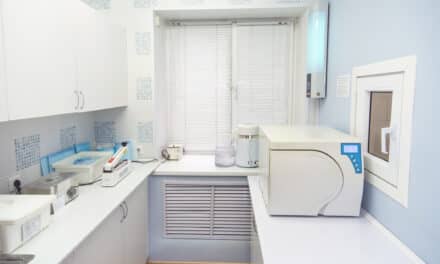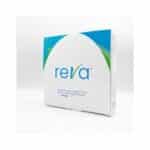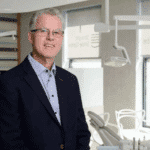by Sarah schmelling
Marc S. Lemchen, DMD, runs the largest office in New York with a blend of computers and kindness
For some in the medical community, “going paperless” is a new phenomenon, an innovative and modern way to redesign an office. But for Marc S. Lemchen, DMD, it’s a concept he’s had from the beginning of his practice—in 1974.
“Technology has really made things easier,” he says. “It helps save us time and money, making us more efficient—and that means we’re giving a better experience to the patient.”
Certainly, with the largest orthodontic practice in New York City, and seeing an average of about 120 patients per day, Lemchen needs that kind of efficiency. But from online patient forms, to a custom office-messaging system, to the arrival of fingerprint check-in, Lemchen and his staff are doing everything they can to make the practice as streamlined—and paper-free—as possible.
A Technological Outlook
The idea to become an orthodontist, and to infuse technology into his practice, stems from the 2 years Lemchen spent in the Air Force after dental school. He was assigned to treat the children of Air Force members in Japan, where televisions were already being used to entertain patients during appointments. He liked working with kids so much that he returned to the United States for orthodontic training.
From the very beginning of his practice, he says, “We wanted to use technology to make our practice better and to differentiate it from others.” In his first office, he set up a television at each chair and, as early as 1975, installed a central VCR to show videos at all of the stations.
But this was just the beginning. “Then, we started thinking about technology as a way to save us time and money,” Lemchen says. And since “one of the most precious things in New York is space,” he explains, the first thing they did was try to make more of it. “We began thinking about treatment cards,” and how much time, labor, and space they entailed, he says. “If you’re seeing 70 or 80 patients a day, you’re pulling 70 or 80 charts and filing them away. So it became clear that if you don’t have to do that, you can have one less person working in your office, and that’s one less salary and one less body taking up space,” he says. This led to the office’s first computer system in 1984. Computers were installed at every chair, and all of the treatment-card information was entered there.
By 1988, Lemchen was thinking about ways to digitize x-rays. “I looked at one program at a convention and asked the question, ‘If we can measure the x-ray, why can’t we measure it directly from the head?’ ” he explains. From this idea, he created a product that eventually become a major imaging system used widely in the industry today. It was one of the first of several patents he now holds in the computer arena.
In fact, Lemchen now has a full-time programmer on his staff to help him develop similar innovations. “A lot of software in orthodontics is developed by a company … where people sit and do programming, and come up with a concept of how an office should run after talking to a few orthodontists and trying to glean information from them,” he says. “And I think it’s very possible, at that point, to come up with a project that pleases no one.”
He says that his office has taken a more direct approach by working with the programmer in the office, so that person can see firsthand what is required. For example, Lemchen and his in-office programmer developed a messaging system where every phone message and reply are automatically documented in a patient’s chart.
“So we no longer have to double-enter things,” he says. “It’s another way of saving time, because even if it just saves a minute here and there, those minutes build. If you saved everybody 5 minutes, and you have 25 employees, you’re saving 125 minutes of time in labor. You do that in a couple of ways, and you can save one whole person’s job. All of these little things you do with technology can add up.”
This love of technology also carries over into Lemchen’s use of state-of-the-art appliances and equipment. An early adapter of lingual braces, aligners, and other custom appliances, he says using all of this innovation can make you a better orthodontist. “You spend less time doing the things that make you less productive and more time doing things that are productive.”
Patient Impressions
Today, Lemchen has an up-to-the-minute office with another orthodontist, Jennifer Salzer, DDS. The staff includes five hygienists, nine chairside assistants, two sterilization assistants, five front-desk people, one accountant, two office managers, the computer programmer, and a lab technician.
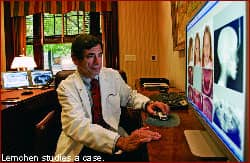
The office also has video monitors of all the chairs at the front desk, both so patients can be moved through more efficiently, and so parents can keep their children in view at all times. The most recent technological advancement, Lemchen says, is a fingerprint check-in system where patients put a finger down and their name pops up on the screen.
In addition to all the obvious efficiency benefits that this kind of technology provides, Lemchen believes it can also enhance the overall patient experience. “My feeling has always been that you have to give the patient something special to talk about when they leave the office,” he says.
He noticed this was happening as soon as the practice was computerized. “Patients would leave and say, ‘That’s such a great office,’ ” he says. “They’d talk to people about how all the charts are on computers, about the panoramic x-ray machine—as opposed to just saying, ‘I picked Johnny up and we went to the orthodontist and the shoe store.’ ”
But Lemchen isn’t just interested in patients having a good perception of the office; he wants them to truly benefit from all the innovations he uses.
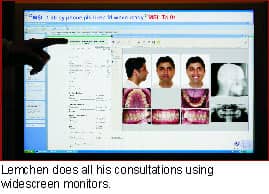
Because of this, he now sets one appointment with the patient to take the images and show them the technology, but then he sets a second appointment to sit down with the patient (“in an office chair, not a dental chair,” Lemchen points out) and discuss the choices they have and what can be done to meet their expectations. “I find that this really covers a lot of ground over those next few years of treatment,” he says. “Patients always remember a lot from that initial consultation.”
Lemchen adds that the technology in the office can be used to show the patient all the work that’s been done with them over the course of their treatment, and in short, make the patient appreciate the service more. “If the patient doesn’t appreciate us as orthodontists, it’s our fault,” he says. “But if you just bring up the before-and-after images to them right there, you can say, ‘Can you believe these used to be your teeth?’ Things happen slowly, and 2 years is a long time. There’s a big difference from where they were 2 years ago, but you have to show them. They won’t appreciate us unless they’re aware of what we’re doing.”
Truly Paperless
However, the overriding idea behind all of this technology is the concept of being paperless—or actually being beyond paperless. Some orthodontists consider their offices paperless, but they’re scanning papers and charts into the computers, so “there was paper there at one point,” Lemchen says. “Scanning, in paperless, is cheating.”
“Beyond paperless,” he says, is a system of “electronically following a patient through all the steps of their treatment without ever having a piece of paper to use as a guide.” This means that absolutely everything—charts, appointments, phone messages, emails, and prescriptions—are all only on a computer.
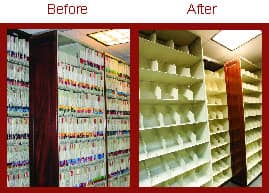
What does a paperless office mean for patients? Primarily that they spend less time at their appointments, he says. “They show up, and they’ve already filled out a form on our Web site. And at home, they have had more opportunity to be thoughtful about how they fill it out and to put in all the things that are important to them. That’s already more efficient.”
Then, he says, all of the different elements of the paperless technology—such as the messaging system and the electronic treatment cards—save more time from the second the patient arrives.
Lemchen also uses time-saving technology in contacting patients’ dentists. Previously, if he wanted a dentist to look at a patient’s tooth, he had to write a letter or try to contact that dentist by phone—both of which took time. Now, he simply clicks on the dentist’s email address within the patient’s file and digitally sends that physician the patient’s treatment card. “That takes less than a minute,” he says. “Just multiply that by 120 or 150 patients per day.”
The Office Ideal
Keeping such a large office—and one on Park Avenue in Manhattan, no less—running smoothly goes beyond technology, though, Lemchen says. He’s a firm believer in starting early, and says he arrives at the office at 6 am. From then until 7:30 am he goes over cases, he says, and then he does consultations until 8:30 am. Regular visits are conducted from 9 am to 1 pm, then there’s lunch. Lemchen does more consultations, and they’re finished by 6 pm. In June and September, with so many of his patients going off to (and then returning from) summer camp, the staff begins regular visits 1 hour earlier, at 8 am. But then in July and August, when the kids are mostly away, the office is closed on Mondays to take advantage of the lighter load.
Lemchen also believes in giving gifts, first because it’s fun and second because, especially in summer, it keeps the orthodontist’s office on the kids’ radar when they go away to camp. The office always gives kids a “camp box” with basics like toothbrushes and floss, but it also sends them off with gifts like giant beach towels, sweatshirts, or beach bags—none of which have Lemchen’s name printed on them, “so they’re not too hokey,” he says. The office also often sends patients packages at camp with gifts like stationery and pencils, because all kids “love to get things at camp,” he says.
But an even bigger nontechnological aspect of the office that Lemchen holds dear is the goal of providing great customer service to ensure that every patient is happy. “We never stand back and say, ‘We don’t need that patient,’ ” he says, explaining that the staff knows that they should do everything they can to keep the patient content, and if he hears about a problem that hasn’t been resolved, that means they’ve failed. “Our job is to deal with all of our patients,” he says. “I’m never going to ask [a patient] to leave the practice.”
He is proud of the reputation the office has among patients for having such a helpful staff. “We want people to leave saying, ‘The people there are so nice, and they took such great care of us and we got such good results,’ ” he adds. “We want to give them those things to say.”
In fact, this idea of providing a patient with such a good experience that they leave wanting to tell people about it is the core of Lemchen’s practice philosophy. “I always say that a satisfied patient is not what we want,” he says. “We want a patient who’s thrilled.”
Sarah Schmelling is a contributing writer for Orthodontic Products.
Practice Profile
Name: Marc S. Lemchen, DMD
Location: 553 Park Avenue, New York
Specialty: Orthodontics
Years in practice: 31
Patients per day: 115
Starts per year: 600
Days worked per week: 5–6
Office square footage: 3,000
Number of Employees: 22




